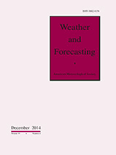
WEATHER AND FORECASTING
Scope & Guideline
Connecting Research and Practice in Meteorology
Introduction
Aims and Scopes
- Numerical Weather Prediction (NWP):
The journal emphasizes the development and evaluation of numerical models for weather forecasting, including advancements in model physics, data assimilation techniques, and resolution enhancement. - Severe Weather Forecasting:
Research on the prediction of severe weather events such as hurricanes, tornadoes, and heavy precipitation is a core focus, with studies investigating methodologies to improve accuracy and reliability. - Impact-Based Decision Support Systems (IDSS):
The journal explores the creation and validation of decision support tools that integrate weather forecasts with risk assessments to aid public safety and emergency management. - Machine Learning and Artificial Intelligence in Meteorology:
The incorporation of machine learning techniques for data analysis and forecasting is increasingly prevalent, focusing on innovative applications that enhance predictive capabilities. - Climate Variability and Predictability:
Research addressing the impacts of climate phenomena such as El Niño and their relationship with weather patterns is an important aspect, contributing to longer-term forecasting.
Trending and Emerging
- Integration of Remote Sensing Data:
Research increasingly focuses on utilizing remote sensing technologies to enhance weather prediction accuracy, reflecting advancements in satellite and radar technology. - Real-Time Data Assimilation Techniques:
There is a growing interest in real-time data assimilation methods that improve the responsiveness and accuracy of weather forecasts, particularly during severe weather events. - Probabilistic Forecasting and Uncertainty Quantification:
The trend towards probabilistic forecasting is rising, with an emphasis on quantifying uncertainty in predictions to better inform decision-making processes. - Climate Change Impact Studies:
Emerging research is increasingly focused on understanding how climate change affects weather patterns and forecasting, with implications for long-term prediction and adaptation strategies. - Public Engagement and Communication of Weather Information:
Studies exploring effective communication strategies for conveying weather information to the public are gaining prominence, particularly in the context of severe weather warnings.
Declining or Waning
- Traditional Statistical Forecasting Methods:
There is a noticeable decrease in research focusing on conventional statistical methods for weather prediction, as newer machine learning approaches gain traction. - Local Climate Studies:
Research specifically centered on localized climate phenomena has become less common, possibly overshadowed by broader studies addressing global or regional climate impacts. - Historical Weather Data Analysis:
The journal has seen fewer contributions dedicated to the analysis of historical weather data, as the emphasis shifts towards real-time forecasting and predictive modeling. - Empirical Model Development:
The development of empirical models based on observational data appears to be waning, with a growing preference for sophisticated numerical and hybrid modeling approaches. - Basic Meteorological Education and Outreach:
Papers focused on educational aspects and outreach initiatives in meteorology have declined, possibly due to the journal's shift towards more technical and research-driven content.
Similar Journals
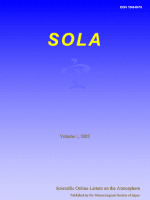
SOLA
Pioneering open access to innovative meteorological insights.SOLA is a distinguished journal published by the Meteorological Society of Japan, focusing on cutting-edge research in the field of atmospheric science. Since transitioning to an Open Access model in 2018, SOLA aims to facilitate the dissemination of knowledge and foster collaboration among researchers from around the globe. With a proud history spanning from 2005 to 2024, the journal has earned a reputation for high-quality publications, achieving a Q1 ranking in Atmospheric Science according to the 2023 category quartiles. Although its H-Index is currently not available, SOLA is recognized in Scopus rankings, standing at #82 out of 148 in Earth and Planetary Sciences, demonstrating its impact in the field. With its headquarters in Tokyo, Japan, and an unwavering commitment to advancing scientific understanding, SOLA serves as an essential resource for researchers, professionals, and students dedicated to exploring the complexities of atmospheric phenomena.

Asia-Pacific Journal of Atmospheric Sciences
Unlocking the Secrets of Our AtmosphereWelcome to the Asia-Pacific Journal of Atmospheric Sciences, a leading publication in the field of atmospheric science, published by the Korean Meteorological Society. With an ISSN of 1976-7633 and an E-ISSN of 1976-7951, this journal has been a cornerstone for researchers and practitioners in the atmospheric sciences since its inception in 2008. Recognized for its rigorous peer-reviewed articles, it holds a commendable Q2 quartile ranking in 2023 and is placed at the 51st rank out of 148 in the Earth and Planetary Sciences, reflecting its impact within the community with a 65th percentile. The journal features a broad scope encompassing meteorology, climatology, and environmental sciences, making it an essential resource for scholars and industry experts alike. As an open access journal, it ensures that groundbreaking research is widely accessible, fostering collaboration and innovation across the Asia-Pacific region and beyond. Explore the latest findings and advancements in atmospheric sciences and contribute to the dynamic field of climate research through the journal's engaging content.
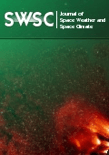
Journal of Space Weather and Space Climate
Charting New Frontiers: The Premier Journal on Space Weather InsightsThe Journal of Space Weather and Space Climate is a premier, internationally recognized open-access journal published by EDP Sciences S A, dedicated to advancing the understanding of the intricate interactions between solar and geophysical phenomena. With an ISSN of 2115-7251, this journal has been at the forefront of research since 2011, fostering discussions and disseminating findings related to atmospheric and planetary sciences. The journal ranks in the top quartile for both Atmospheric Science and Space and Planetary Science, highlighting its critical role in the academia with Scopus rankings placing it at #24 out of 104 in Space and Planetary Science and #35 out of 148 in Atmospheric Science. Based in France, it offers seamless access to cutting-edge research, motivating researchers, professionals, and students to contribute to the growing knowledge in this vital field. The journal's commitment to open access ensures that impactful research reaches an extensive audience, promoting collaborative efforts to tackle issues related to space weather and climate change.
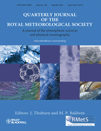
QUARTERLY JOURNAL OF THE ROYAL METEOROLOGICAL SOCIETY
Elevating meteorological knowledge since 1873.The Quarterly Journal of the Royal Meteorological Society, published by Wiley, stands as a prestigious platform in the field of Atmospheric Science, with a commendable impact reflected in its Q1 quartile ranking and a notable Scopus rank of 4th out of 148, placing it in the 97th percentile among its peers. With origins tracing back to 1873, this journal has established itself as a cornerstone for disseminating high-quality research, engaging articles, and innovative methodologies that advance our understanding of meteorological phenomena. Although it is not an open-access journal, the rigorous peer-review process ensures that only the most significant contributions are published, making it essential reading for researchers, professionals, and students dedicated to atmospheric and planetary sciences. For those interested in cutting-edge findings and comprehensive reviews, the Quarterly Journal of the Royal Meteorological Society is an invaluable resource in enhancing scientific knowledge and collaboration in this dynamic and evolving field.

Atmospheric Science Letters
Empowering global collaboration in atmospheric science.Atmospheric Science Letters, published by WILEY, is a leading open-access journal in the field of Atmospheric Science. Since its establishment in 2000, it has significantly contributed to advancing knowledge related to the Earth's atmosphere, focusing on both theoretical and practical aspects. With an impressive Q2 ranking in the Atmosphere Science category as of 2023 and a Scopus rank of 62 out of 148, this journal provides a platform for researchers and professionals to share their findings and insights. The journal’s commitment to open access since 2016 ensures that cutting-edge research is accessible to a global audience, fostering collaboration and innovation in the atmospheric sciences. Addressed from its headquarters at 111 River St, Hoboken, NJ, USA, Atmospheric Science Letters is pivotal for students, researchers, and professionals seeking to stay abreast of the latest developments in this dynamic field.
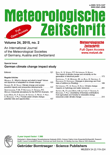
METEOROLOGISCHE ZEITSCHRIFT
Illuminating the Science of Weather PatternsMETEOROLOGISCHE ZEITSCHRIFT is a distinguished academic journal dedicated to the field of meteorology and atmospheric sciences, published by E SCHWEIZERBARTSCHE VERLAGSBUCHHANDLUNG. With an ISSN of 0941-2948 and an E-ISSN of 1610-1227, this journal has been an invaluable resource for researchers, professionals, and students since its inception. It has embraced an Open Access model since 2014, promoting wider dissemination of research findings. Based in Stuttgart, Germany, the journal is recognized for its rigorous peer-review process and is currently positioned in the Q3 quartile for Atmospheric Science as per the 2023 category rankings. Additionally, it ranks #97 out of 148 in the Scopus database, placing it in the 34th percentile among Earth and Planetary Sciences. Covering a broad spectrum of topics relevant to meteorology, METEOROLOGISCHE ZEITSCHRIFT serves as a platform for innovative research and theoretical contributions, aiming to advance understanding of atmospheric phenomena and their implications for climate and weather. Researchers and practitioners alike will find valuable insights within its pages, making it a significant asset in the landscape of meteorological scholarship.

GEOMAGNETISM AND AERONOMY
Fostering Understanding of Earth's Magnetic and Atmospheric InteractionsGEOMAGNETISM AND AERONOMY, published by MAIK NAUKA/INTERPERIODICA/SPRINGER, is a prominent journal dedicated to advancing the fields of geophysics and planetary science. With ISSN 0016-7932 and E-ISSN 1555-645X, this journal serves as a critical platform for researchers to disseminate their findings on geomagnetic phenomena and aeronomical studies, fostering a deeper understanding of Earth's magnetic field dynamics and atmospheric interactions. Spanning publishing years from 1996 to 2024, it is categorized in the Q3 quartile for geophysics and Q4 for space and planetary science, reflecting its positioning within the academic landscape. Although not open access, readers and researchers can access valuable insights into geomagnetic and atmospheric research, contributing to ongoing discourse in these vital scientific domains. With a focus on innovative research, GEOMAGNETISM AND AERONOMY remains an essential resource for professionals and students aiming to deepen their expertise in Earth and planetary sciences.

TELLUS SERIES A-DYNAMIC METEOROLOGY AND OCEANOGRAPHY
Empowering Scholars with Open Access ResearchTELLUS SERIES A-DYNAMIC METEOROLOGY AND OCEANOGRAPHY, published by Stockholm University Press, is a prestigious open-access journal that has been at the forefront of research in the fields of atmospheric science and oceanography since its inception in 1983. With an enduring commitment to disseminating high-quality, peer-reviewed research, the journal has achieved a commendable impact factor, securing its position in the Q2 category for both Atmospheric Science and Oceanography as of 2023. The journal's significant reach is reflected in its Scopus rankings, being positioned at Rank #51 in Oceanography and Rank #77 in Atmospheric Science. With open access established since 2012, TELLUS SERIES A serves not only as a vital resource for researchers and professionals in these dynamic fields but also as an inclusive platform for budding scholars and students. Engaging with this journal allows readers to stay updated on the latest developments and groundbreaking discoveries that advance our understanding of climate systems and marine environments. Its editorial ethos emphasizes the cross-disciplinary integration of atmospheric and oceanographic studies, making it an essential publication for anyone invested in environmental research and policy.

METEOROLOGICAL APPLICATIONS
Exploring Innovative Solutions for Atmospheric ChallengesMETEOROLOGICAL APPLICATIONS is an esteemed journal published by WILEY that has been a vital resource in the field of atmospheric science since its inception in 1994. With an Impact Factor indicative of its credibility and influence in the academic community, the journal has notably achieved a Q2 ranking in the 2023 category quartiles for Atmospheric Science, demonstrating its commitment to advancing knowledge in meteorology. As an Open Access journal since 2020, it provides widespread accessibility to researchers, professionals, and students, promoting collaborative efforts in the pursuit of innovative solutions to atmospheric challenges. With its dedicated focus on interdisciplinary studies in meteorology, METEOROLOGICAL APPLICATIONS serves as a crucial platform for sharing cutting-edge research and fostering dialogue among experts, thereby enhancing our understanding of weather phenomena and their global impacts. For submissions and accessing articles, the journal can be found at WILEY’s headquarters in Hoboken, NJ, representing a hub for scholarly discourse in the atmospheric sciences.

Journal of Operational Meteorology
Advancing Weather Insights for a Changing WorldJournal of Operational Meteorology, published by the Natl Weather Assoc, is a pivotal resource in the intersecting fields of atmospheric science, computer science in earth sciences, and management science and operations research. With an ISSN of 2325-6184, this journal has established itself as a key player in operational meteorology, driving advancements in weather forecasting, climate modeling, and meteorological applications. Since its inception in 2019, it has garnered attention in various quartiles, ranking Q2 in both computers in earth sciences and management science categories, and Q3 in atmospheric science, indicating its growing influence in these disciplines. Researchers and practitioners alike benefit from its curated access to innovative methodologies, case studies, and theoretical insights that are crucial for advancing meteorological practices. Though it is currently not open access, the journal remains committed to disseminating essential research that informs both academic inquiry and practical application in the ever-evolving landscape of meteorology. With its base in the United States, the Journal of Operational Meteorology continues to attract contributions that reflect the latest trends and challenges in weather and climate research, making it an indispensable tool for those engaged in these vital studies.